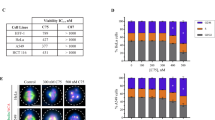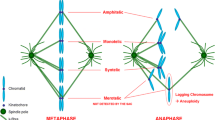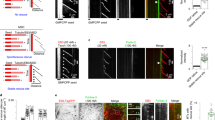Summary
Peloruside A (PelA), a novel microtubule-stabilizing agent and potential anti-cancer drug, isolated from the marine sponge Mycale hentscheli, binds to a distinct, non-taxoid binding site on tubulin. Using live-cell confocal microscopy, the effects of PelA on microtubule dynamics were quantified in a human breast adenocarcinoma cell line (MCF7) stably expressing GFP-α-tubulin. Changes in microtubule length were tracked over time in cells treated with PelA concentrations ranging from 3.8–100 nM. As with other microtubule-targeting drugs like paclitaxel and epothilone B, microtubule dynamics were suppressed in a concentration-dependent manner. At the PelA IC50 concentrations for cell proliferation (3.8 nM) and G2/M block (25 nM), PelA inhibited dynamicity by 23% and 45%, respectively. At 25 nM PelA, effects included a 24% and 41% reduction in average growth rate and growth length, respectively. Additionally, the total time spent in pause increased by 53% and coincided with a 36% reduction in the average amount of time spent growing. Rescue and catastrophe frequencies were not significantly affected by PelA, except for length-based catastrophe (67% increase). The results provide further insight into PelA’s unique mode of stabilization and contribute to our understanding of how microtubule-targeting agents exert their anti-mitotic effects.






Similar content being viewed by others
Abbreviations
- EpoB:
-
epothilone B
- MSA:
-
microtubule stabilizing agent
- MTA:
-
microtubule targeting agent
- PelA:
-
peloruside A
References
West LM, Northcote PT, Battershill CN (2000) Peloruside A: a potent cytotoxic macrolide isolated from the New Zealand marine sponge Mycale sp. J Org Chem 65:445–449
Hood KA, West LM, Rouwé B, Northcote PT, Berridge MV, Wakefield SJ, Miller JH (2002) Peloruside A, a novel antimitotic agent with paclitaxel-like microtubule-stabilizing activity. Cancer Res 62:3356–3360
Gaitanos TN, Buey RM, Díaz JF, Northcote PT, Teesdale-Spittle P, Andreu JM, Miller JH (2004) Peloruside A does not bind to the taxoid site on β-tubulin and retains its activity in multidrug-resistant cell lines. Cancer Res 64:5063–5067
Huzil JT, Chik JK, Slysz GW, Freedman H, Tuszynski J, Taylor RE, Sackett DL, Schriemer DC (2008) A unique mode of microtubule stabilization induced by peloruside A. J Mol Biol 378:1016–1030
Pineda O, Farras J, Maccari L, Manetti F, Botta M, Vilarrasa J (2004) Computational comparison of microtubule-stabilising agents laulimalide and peloruside with Taxol and colchicine. Bioorg Med Chem Lett 14:4825–4829
Jiménez-Barbero J, Canales A, Northcote PT, Buey RM, Andreu JM, Díaz JF (2006) NMR determination of the bioactive conformation of peloruside A bound to microtubules. J Am Chem Soc 128:8757–8765
Jordan MA, Wilson L (2004) Microtubules as a target for anticancer drugs. Nat Rev Cancer 4:253–265
Singh P, Rathinasamy K, Mohan R, Panda D (2008) Microtubule assembly dynamics: an attractive target for anticancer drugs. IUBMB Life 60:368–375
Meyer C, Ferguson D, Krauth M, Wick M, Northcote P (2006) RTA 301 (peloruside): a novel microtubule stabilizer with potent in vivo activity against lung cancer and resistant breast cancer. 18th EORTC-NCI-AACR Symposium on Molecular Targets and Cancer Therapeutics, Prague, Czech Republic, November 7–10, 2006, Abstr No. 639. (for pdf, see: (http://www.sciencedirect.com/science/article/B75GT-4MMF4DM-ST/2/901656de391d50b1ced2b7ad843d922a) (doi:10.1016/S1359-6349(06)70644-9))
Mitchison T, Kirschner M (1984) Dynamic instability of microtubule growth. Nature 312:237–242
Nogales E (2001) Structural insights into microtubule function. Annu Rev Biophys Biomol Struct 30:397–420
Horio T, Hotani H (1986) Visualization of the dynamic instability of individual microtubules by dark-field microscopy. Nature 321:605–607
Janosi IM, Chretien D, Flyvbjerg H (2002) Structural microtubule cap: stability, catastrophe, rescue, and third state. Biophys J 83:1317–1330
Panda D, Miller H, Banerjee A, Ludueña R, Wilson L (1994) Microtubule dynamics in vitro are regulated by the tubulin isotype composition. Cell Biol 91:11358–11362
Honore S, Kamath K, Braguer D, Wilson L, Briand C, Jordan MA (2003) Suppression of microtubule dynamics by discodermolide by a novel mechanism is associated with mitotic arrest and inhibition of tumor cell proliferation. Mol Cancer Ther 2:1303–1311
Wilmes A, Bargh K, Kelly C, Northcote PT, Miller JH (2007) Peloruside A synergizes with other microtubule stabilizing agents in cultured cancer cell lines. Mol Pharmaceut 4:269–280
Kamath K, Jordan MA (2003) Suppression of microtubule dynamics by epothilone B is associated with mitotic arrest. Cancer Res 63:6026–6031
Dhamodharan R, Wadsworth P (1995) Modulation of microtubule dynamic instability in vivo by brain microtubule associated proteins. J Cell Sci 108:1679–1689
Yvon A-MC, Wadsworth P, Jordan MA (1999) Taxol suppresses dynamics of individual microtubules in living human tumor cells. Mol Biol Cell 10:947–959
Brandt R, Lee G (1994) Orientation, assembly, and stability of microtubule bundles induced by a fragment of tau protein. Cell Motil Cytoskelet 28:143–154
Honore S, Kamath K, Braguer D, Horwitz SB, Wilson L, Briand C, Jordan MA (2004) Synergistic suppression of microtubule dynamics by discodermolide and paclitaxel in non-small cell lung carcinoma cells. Cancer Res 64:4957–4964
Buey R, Barasoain I, Jackson E, Meyer A, Giannakakou P, Paterson I, Mooberry S, Andreu J, Díaz F (2005) Microtubule interactions with chemically diverse stabilizing agents: thermodynamics of binding to the paclitaxel site predicts cytotoxicity. Chem Biol 12:1269–1279
Turner PF, Margolis RL (1984) Taxol-induced bundling of brain-derived microtubules. J Cell Biol 99:940–946
Schulze E, Kirschner M (1987) Dynamic and stable populations of microtubules in cells. J Cell Biol 104:277–288
Chapin SJ, Bulinski JC, Gundersen G (1991) Microtubule bundling in cells. Nature 349:24–24
Dhamodharan R, Jordan MA, Thrower D, Wilson L, Wadsworth P (1995) Vinblastine suppresses dynamics of individual microtubules in living interphase cells. Mol Biol Cell 6:1215–1229
Amos LA (2004) Microtubule structure and its stabilisation. Org Biomol Chem 2:2153–2160
Wade R (2007) Microtubules: an overview. In: Zhou J (ed) Microtubule protocols, vol. 137. Humana Press, Totowa, pp 1–16
Dimitrov A, Quesnoit M, Moutel S, Cantaloube I, Pous C, Perez F (2008) Detection of GTP-tubulin conformation in vivo reveals a role for GTP remnants in microtubule rescues. Science 322:1353–1356
Acknowledgments
This work was supported by grants from the Cancer Society of New Zealand and Victoria University of Wellington and a postgraduate scholarship from the Genesis Oncology Trust to A. Chan. We thank Daniel Logan and Cameron Jack for their assistance in setting up the necessary software for measuring microtubule dynamics, and Sushila Pillai for her invaluable assistance using the confocal microscope. We also thank Paraskevi Giannakakou for supplying the GFP-tubulin transfected cells and her constructive feedback regarding the manuscript.
Author information
Authors and Affiliations
Corresponding author
Rights and permissions
About this article
Cite this article
Chan, A., Andreae, P.M., Northcote, P.T. et al. Peloruside A inhibits microtubule dynamics in a breast cancer cell line MCF7. Invest New Drugs 29, 615–626 (2011). https://doi.org/10.1007/s10637-010-9398-2
Received:
Accepted:
Published:
Issue Date:
DOI: https://doi.org/10.1007/s10637-010-9398-2




